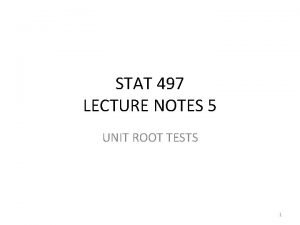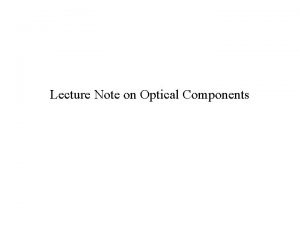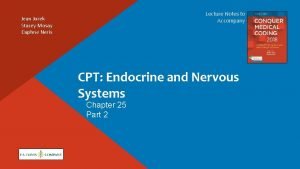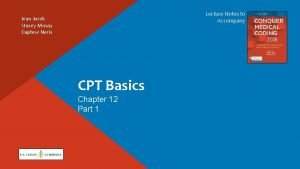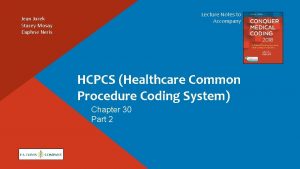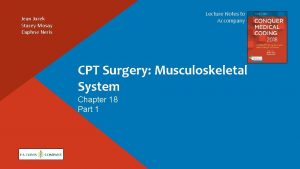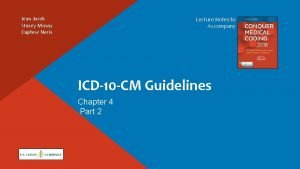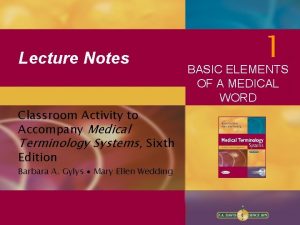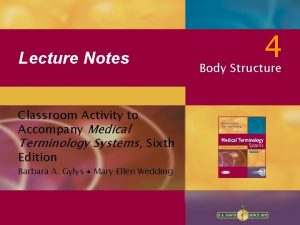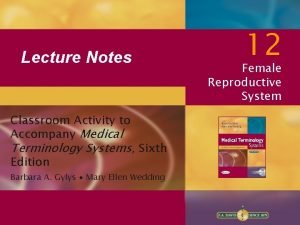Lecture Notes to Accompany Jean Jurek Stacey Mosay

































- Slides: 33

Lecture Notes to Accompany Jean Jurek Stacey Mosay Daphne Neris Pathology and Laboratory Codes Chapter 28

Outline Pathology and Laboratory Overview Modifiers Major Pathology and Laboratory Procedures Copyright © F. A. Davis 2018 2

Learning Outcomes After completing this presentation, you should be able to: 1. Explain the difference between the professional and technical components of the pathology and laboratory medicine services and determine whether a pathology or laboratory service requires modifier – 26 or modifier –TC. 2. Explain the specific coding rules associated with reporting panel codes. 3. Distinguish between qualitative and quantitative drug testing. 4. Describe the basis for code selection in molecular pathology. 5. Determine if one or more pathology codes are needed based on the specimens received by the surgical pathology department. 6. Understand the different types of pathology consultation services. Copyright © F. A. Davis 2018 3

Pathology and Laboratory Overview Copyright © F. A. Davis 2018 4

Codes in the Pathology and Laboratory sections are broken into which of the following component parts? (Choose all that apply. ) A. Analytical B. Professional C. Surgical D. Technical

Pathology and Laboratory General Guidelines List as many CPT codes from this section as necessary to capture all of the services performed. Unlisted procedures are also available for use for most subsections but should be assigned only after checking for a Category III or HCPCS Level II code. In this section, codes do not include specimen collection unless otherwise stated in the parenthetical notes or in the instructions before or below the code. With respect to Medicare patients, always check HCPCS for specific laboratory testing codes before assigning codes from this section. Copyright © F. A. Davis 2018 6

Location of Testing Physician offices Clinics Reference laboratories Hospital-based laboratories Copyright © F. A. Davis 2018 7

Organization of the Pathology and Laboratory Sections Codes begin with the number 8. Code ranges are organized by type of service, not by anatomy. There are 20 subsections. Note miscellaneous codes located under “other procedures. ” Specimen collection is usually coded separately from pathology and laboratory test codes. Venipuncture by laboratory personnel use code range 36400– 36425. Specimens sent offsite for testing use code 99000 or 99001 for handling and transferring. Copyright © F. A. Davis 2018 8

Physician Orders and Test Requisitions Every laboratory test must be ordered by a physician (MD), physician assistant (PA), or registered nurse practitioner (RN-P). For every laboratory test ordered, a test requisition must be sent that specifies which tests to perform on the specimen and supplies a diagnosis or reason for the test, even if it is a sign or symptom, to justify its medical necessity. Copyright © F. A. Davis 2018 9

Complete Laboratory Codes Includes Ordering procedure or test Obtaining sample or specimen Handling specimen Performing actual procedure or test Analyzing and interpreting results Copyright © F. A. Davis 2018 Example A bone marrow biopsy is performed by a surgeon with the specimen sent to a pathologist for review and interpretation. Surgeon reports 38221 (biopsy). Pathologist reports 88305– 26 (review and Interpretation). Facility reports 38221 and 88305–TC (surgery and technical component of specimen processing). 10

Modifier – 26 is used when coding the technical component of a service. (True or False? ) A. True B. False

Modifiers Copyright © F. A. Davis 2018 12

Major Pathology and Laboratory Procedures Copyright © F. A. Davis 2018 13

Organ or Disease-Oriented Panels To bill a panel code, all of the listed tests must be performed. No substitutions are permitted. If fewer tests are performed, individual CPT codes for each test should be reported, not the panel code. In CPT, the individual test codes can be located quickly because each test listed under the panel has its associated CPT code next to it for quick reference. It is the coder’s responsibility to recognize and bill a panel code, even if the physician orders each test individually. Copyright © F. A. Davis 2018 14

When billing for a panel code: (Choose all that apply. ) A. All of the listed tests must be performed. B. All substitute tests must be included. C. HCPCS codes are listed first. D. It is the coder’s responsibility to recognize and bill a panel code.

Drug Testing Qualitative—Is drug or metabolite there or not? Quantitative—How much of the drug is in the patient’s system? Drug assay subsections Therapeutic drug assay Drug assay Chemistry Copyright © F. A. Davis 2018 16

Evocative or Suppression Testing measures how endocrine glands are working. It evaluates the patient’s endocrine status. It also evaluates the patient’s response to certain agents intended to stimulate or suppress a particular hormone. Each code depicts a panel listing the specific analyte and number of times it must be tested. Example: 80430 Growth hormone suppression panel (glucose administration). This panel must include the following: Glucose (82947 x 3) Human growth hormone (HGH) (83003 x 4) Copyright © F. A. Davis 2018 17

Urinalysis 1. Determine if the method used was automated or manual where a visual color comparison was made. 2. Determine if a microscopic study was performed. Some laboratories routinely do this as their standard protocol for all urinalysis. 3. If a timed urine collection urinalysis is performed, assign code 81050 for each timed sample. Example: A 30 -year-old female presents for her annual gynecology examination. A medical assistant performs a urinalysis using a dipstick. She compares the colors on the strip to the control colors on the box. The physician also viewed the sample under the microscope. Code: 81000. Copyright © F. A. Davis 2018 18

Molecular Pathology Tier-1 Section Most commonly performed tests Contains 10 codes (81200– 81383) Describes specific gene and genomic procedures Tier-2 Section Copyright © F. A. Davis 2018 Less often performed tests Contains nine codes (81400– 81408) Report molecular pathology procedures not specifically described in Tier-1 Categorizes services based on the complexity of the methodologies used to perform tests and resources required accordingly 19

Molecular pathology code selection is based on the specific gene being analyzed. (True or False? ) A. True B. False

Chemistry Calculations in reporting the results are included in the code description. The majority of the tests in this section are considered to be quantitative. When an analyte is measured in multiple specimens from different sources, assign modifier – 59. The analyte is reported separately for each source and for each specimen. Copyright © F. A. Davis 2018 21

Hematology and Coagulation Tests performed on blood and blood components Count, type, and size of blood cells Hematology The study of blood Counting the cells in blood Coagulation Measures how fast the blood will clot Bleeding times, hemograms, blood count, clotting factor analysis, prothrombin time, coagulation time, viscosity, and thromboplastin time Copyright © F. A. Davis 2018 Example: The physician performs an automated complete blood count (CBC) with automated differential. The white blood cell (WBC) is abnormal and a manual differential is performed to confirm this value. Code: 85027, 85007 22

Immunology 1. Identify the specific organism or disease related to the test. 2. Determine if the procedure performed is to detect antigens or antibodies. 3. If performed on antibodies, which type and number of antibodies are being tested? 4. Does the test measure multiple antibody subclasses or species? 5. Determine the method used to perform the test. 6. When performing allergen testing, code for each allergen during Ig. E testing. Copyright © F. A. Davis 2018 Example: A patient is suffering from joint pain and a nodule on her right middle finger. The physician orders an antinuclear antibody (ANA) test to rule out rheumatoid arthritis or lupus. Code: 86038 23

Microbiology 1. Determine if smears are performed on the specimen. If so, assign the code for smear (87205– 87207). 2. Determine the culture source or type. Sources can be blood, urine, stool, sputum, and pus. Culture types include pathogen screening, fungal, bacterium, or viral. 3. Assess whether the culture report is a final diagnosis or a presumptive identification. The laboratory report will indicate this. If presumptive, assign a code that states presumptive identification. 4. For final or definitive identification, determine if the isolate type is anaerobic or aerobic. 5. Assign codes. Copyright © F. A. Davis 2018 Example: A patient suffers a superficial wound while hunting. Five days later, the wound appears to be infected and is oozing exudate. The physician orders a C&S of the exudate for anaerobic and aerobic organisms. The sensitivity was conducted by disk method. The laboratory results showed Clostridia with resistance to penicillin G. Code: 87070, 87076, 87184 24

Cytopathology Cervical and vaginal smears Normal—do not require interpretation by the physician Abnormal—physician conducts separate microscopic evaluations The professional and technical component services are in this code range. Physician interpretation code 88141 in addition to the technical component Bethesda Copyright © F. A. Davis 2018 or non-Bethesda reporting system 25

Pathology Consultations Clinical Reflects an opinion requested by another physician or health-care professional on a test that requires additional medical judgment Not a physical specimen submitted to a pathologist but a test result that needs more interpretation Copyright © F. A. Davis 2018 Surgical Also reflects an opinion requested by another physician (surgeon) Regards a physical specimen obtained by surgical procedure 26

A _____ pathology consultation reflects an opinion requested by another physician regarding a test that requires additional medical judgment. A. Clinical B. Conditional C. Surgical D. Technical

Surgical Pathology Six levels—Level I identifies gross examination of tissue only, and Levels II through VI refer to gross and microscopic examination of tissue. Coding rules If several specimens are received in the same container without separate identification, bill only one surgical pathology code. If several specimens are received in the same container and are identified separately, bill each specimen separately. If several specimen bottles are received, bill each specimen using applicable codes for each, based on anatomical part. Each specimen will have its own diagnosis and pathology code. Copyright © F. A. Davis 2018 28

Copyright © F. A. Davis 2018 29

Assigning Pathology and Laboratory Codes A company requires an employee to have a random drug test (screening) performed as part of his drug rehabilitation program. He is a recovering crack cocaine addict. When he arrives at the laboratory, he submits a urine sample. A qualitative drug test was performed. Which code would the laboratory report? 1. What is the test being performed? Drug screening 2. Which specimen or substance is being tested? Cocaine in a urine sample 3. Which method of testing was conducted? Qualitative drug test 4. Which words can be located in the Index? “Drug, ” “screening, ” or “cocaine” 5. Was testing done offsite from where the sample was obtained? No 6. What is the code? 80300 Copyright © F. A. Davis 2018 30

Chapter Summary Codes in the Pathology and Laboratory sections are broken into component parts: technical components and professional components. The predominant issue is modifier – 26 versus –TC. The physician will report the code with modifier – 26 and the laboratory facility will report the code with modifier –TC. To use the panel codes, every test designated within the panel code description must have been performed. Qualitative testing determines the presence or absence of an analyte, constituent, or condition. Quantitative testing determines how much of the analyte is present. In Mo. Path, codes are selected based on the particular gene being analyzed. To code for surgical pathology services, the coder must understand what defines a specimen. Based on that description, the coder will know if one, two, or more codes are needed to complete the surgical pathology service. There are two types of pathology consultation codes: clinical pathology and surgical pathology. Copyright © F. A. Davis 2018 31

Copyright © 2018 by F. A. Davis Company. All rights reserved. This product is protected by copyright. No part of it may be reproduced, stored in a retrieval system, or transmitted in any form or by any means—electronic, mechanical, photocopying, recording, or otherwise—without written permission from the publisher.

Credits Editor-in-Chief: Margaret Biblis Senior Acquisitions Editor: Quincy Mc. Donald Developmental Editor: Amelia L. Blevins Production Manager: Bob Butler Director, Digital Solutions: Kirk Pedrick Developed by Cognition catalysts, helping customers enhance content and empower learners The publisher is not responsible for errors of omission or for consequences from application of information in this presentation, and makes no warranty, expressed or implied, in regard to its content. Any practice described in this presentation should be applied by the reader in accordance with professional standards of care used with regard to the unique circumstances that may apply in each situation. Copyright © F. A. Davis 2018 33
 01:640:244 lecture notes - lecture 15: plat, idah, farad
01:640:244 lecture notes - lecture 15: plat, idah, farad Jaś kukawski
Jaś kukawski Heather jurek
Heather jurek Ljer
Ljer Jurek czyzowicz
Jurek czyzowicz Printers create objects such as prototypes and models.
Printers create objects such as prototypes and models. Hebrews 6:9-12 sermon
Hebrews 6:9-12 sermon Accompany chapter 1
Accompany chapter 1 Venous drainage of hand
Venous drainage of hand Jean baptiste physics
Jean baptiste physics Jean omer marie gabriel monnet
Jean omer marie gabriel monnet Jean monnet jean-gabriel monnet
Jean monnet jean-gabriel monnet Atomic emission spectroscopy lecture notes
Atomic emission spectroscopy lecture notes Unit root time series
Unit root time series Data mining lecture notes
Data mining lecture notes Parallel and distributed computing lecture notes
Parallel and distributed computing lecture notes Optical amplifiers lecture notes
Optical amplifiers lecture notes Atmospheric physics lecture notes
Atmospheric physics lecture notes Money-time relationship and equivalence
Money-time relationship and equivalence Natural language processing lecture notes
Natural language processing lecture notes Advanced operating system notes
Advanced operating system notes Chemistry of carbohydrates notes
Chemistry of carbohydrates notes Electricity and magnetism lecture notes
Electricity and magnetism lecture notes Elements and principles of interior design ppt
Elements and principles of interior design ppt Physics 101 lecture notes pdf
Physics 101 lecture notes pdf Linux lecture notes
Linux lecture notes Nlp lecture notes
Nlp lecture notes 50f7 tolerance
50f7 tolerance Analysis of algorithms lecture notes
Analysis of algorithms lecture notes Health economics lecture notes
Health economics lecture notes Foundation engineering lecture notes
Foundation engineering lecture notes Sensitivity analysis lecture notes
Sensitivity analysis lecture notes Land use planning lecture notes
Land use planning lecture notes Sargur srihari
Sargur srihari













